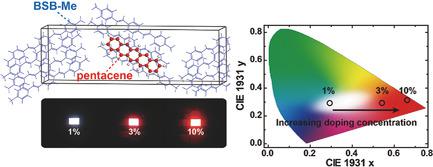当前位置:
X-MOL 学术
›
Adv. Mater.
›
论文详情
Our official English website, www.x-mol.net, welcomes your
feedback! (Note: you will need to create a separate account there.)
Clarification of the Molecular Doping Mechanism in Organic Single‐Crystalline Semiconductors and their Application in Color‐Tunable Light‐Emitting Devices
Advanced Materials ( IF 27.4 ) Pub Date : 2018-09-10 , DOI: 10.1002/adma.201801078 Ran Ding 1, 2 , Xue-Peng Wang 1 , Jing Feng 1 , Xian-Bin Li 1 , Feng-Xi Dong 1 , Wei-Quan Tian 3 , Jia-Ren Du 1 , Hong-Hua Fang 1 , Hai-Yu Wang 1 , Takeshi Yamao 4 , Shu Hotta 4 , Hong-Bo Sun 1, 5
Advanced Materials ( IF 27.4 ) Pub Date : 2018-09-10 , DOI: 10.1002/adma.201801078 Ran Ding 1, 2 , Xue-Peng Wang 1 , Jing Feng 1 , Xian-Bin Li 1 , Feng-Xi Dong 1 , Wei-Quan Tian 3 , Jia-Ren Du 1 , Hong-Hua Fang 1 , Hai-Yu Wang 1 , Takeshi Yamao 4 , Shu Hotta 4 , Hong-Bo Sun 1, 5
Affiliation

|
Organic single‐crystalline semiconductors with long‐range periodic order have attracted much attention for potential applications in electronic and optoelectronic devices due to their high carrier mobility, highly thermal stability, and low impurity content. Molecular doping has been proposed as a valuable strategy for improving the performance of organic semiconductors and semiconductor‐based devices. However, a fundamental understanding of the inherent doping mechanism is still a key challenge impeding its practical application. In this study, solid evidence for the “perfect” substitutional doping mechanism of the stacking mode between the guest and host molecules in organic single‐crystalline semiconductors using polarized photoluminescence spectrum measurements and first‐principles calculations is provided. The molecular host–guest doping is further exploited for efficient color‐tunable and even white organic single‐crystal‐based light‐emitting devices by controlling the doping concentration. The clarification of the molecular doping mechanism in organic single‐crystalline semiconductor host–guest system paves the way for their practical application in high‐performance electronic and optoelectronic devices.
中文翻译:

有机单晶半导体分子掺杂机理的阐明及其在彩色可调发光器件中的应用
具有长周期周期性的有机单晶半导体因其高的载流子迁移率,高的热稳定性和低的杂质含量而在电子和光电子设备中的潜在应用引起了广泛的关注。分子掺杂已被提出作为改善有机半导体和基于半导体的器件性能的有价值的策略。然而,对固有掺杂机制的基本理解仍然是阻碍其实际应用的关键挑战。在这项研究中,“完美”的确凿证据通过偏振光致发光光谱测量和第一性原理计算,提供了有机单晶半导体中客体和主体分子之间堆积模式的替代掺杂机制。通过控制掺杂浓度,分子主体-客体掺杂被进一步开发为有效的颜色可调甚至白色有机单晶基发光器件。对有机单晶半导体主客体系统中分子掺杂机理的阐明为它们在高性能电子和光电设备中的实际应用铺平了道路。
更新日期:2018-09-10
中文翻译:

有机单晶半导体分子掺杂机理的阐明及其在彩色可调发光器件中的应用
具有长周期周期性的有机单晶半导体因其高的载流子迁移率,高的热稳定性和低的杂质含量而在电子和光电子设备中的潜在应用引起了广泛的关注。分子掺杂已被提出作为改善有机半导体和基于半导体的器件性能的有价值的策略。然而,对固有掺杂机制的基本理解仍然是阻碍其实际应用的关键挑战。在这项研究中,“完美”的确凿证据通过偏振光致发光光谱测量和第一性原理计算,提供了有机单晶半导体中客体和主体分子之间堆积模式的替代掺杂机制。通过控制掺杂浓度,分子主体-客体掺杂被进一步开发为有效的颜色可调甚至白色有机单晶基发光器件。对有机单晶半导体主客体系统中分子掺杂机理的阐明为它们在高性能电子和光电设备中的实际应用铺平了道路。











































 京公网安备 11010802027423号
京公网安备 11010802027423号